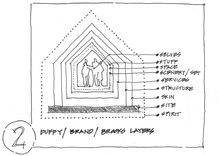COBY MANDERS

QUESTION
Bridging between Theory and Practice.
In other fields people test their intuitions rigorously before they use them or make them public, whereas architects just build their intuitions; in addition, in these other fields these intuitions are based on knowledge. - Amos Rapoport
Omdat ik voortdurend een brug wil slaan tussen doen en denken hecht ik veel belang aan onderzoek en studie. Omdat ik vanuit mijn taak als architect veel verantwoordelijkheid draag in de praktijk moet ik, vind ik, daarover ook reflecteren. Ik ben geïnteresseerd in menswetenschappelijke onderzoeken over de verhouding tussen ontwerpers en opdrachtgevers en de relatie tussen bewoners/gebruikers en de ruimte.
After 10 years of excercising in practice my intuition was telling me that the focus of the designing process should not be 'me', architect or 'it', the building, but 'you', cliënt and future inhabitor. I wondered why architects didn't seem to like thinking about this crucial relationship, whereas I believe that it's the essence of developping good projects, not only beautifull buildings.
'What is Human Architecture?' was my topic in a literature study for the University of Antwerp.
The findings of the study were further developed in a new definition of the notion 'Nearness'*.
Ik verwerk mijn praktische ervaring in pleidooien rond de notie nabijheid/Nearness*, waarbij ik een accent wil leggen op dialoog en communicatie. Om zo voorzichtig een steentje te kunnen bijdragen aan een zich vandaag stilaan ontwikkelend psychologisch, fysiologisch, sensorisch en emotioneel kader rond alle ruimtelijke bezigheden, vanuit alle schalen.
'Ontwerpen betekent afleren wat we denken te weten, geduldig de mechanismen achter onze reflexen ontleden en ons doordringen van het mysterie en de verbluffende complexiteit van onze dagelijkse handelingen.' - Alain De Botton

Topics
Language and communication.
Er is een actuele tendens tot ‘verwetenschappelijking’ van alle (interieur)architectuuropleidingen: ze horen voortaan immers thuis aan de universiteiten. Dat betekent tegelijk meer rationalisering: de taal die architecten in spe er leren spreken staat ver van het gewone en het dagdagelijkse. De afstand tussen ‘leek’-bewoner en ‘expert’-architect die traditioneel gegroeid is, lijkt nog te vergroten. Ik vind dat problematisch: alle vormgegeven ruimte staat immers ten dienste van die ‘leek’, in mijn ogen aanleiding én reden voor alle ruimtelijke activiteit. Zo oefen ik elke dag concreet in communicatie; niet alleen in de taal die we gebruiken als we over architectuur spreken maar ook de leesbaarheid van de plannen en tekeningen die we tonen.
Autonomy and Welfare.
Autonomie (ik), verbondenheid (wij) en competentie (ik, wij en zij) zijn van grote invloed op ons welzijn. Hoe meer we zelf kunnen bepalen vanuit onze eigen wil, hoe beter we ons voelen. Autonomie is het resultaat van je eigen beslissingen nemen en keuzes maken, vanuit je eigen drijfveren en niet gevormd door overtuigende ideeën van anderen, door onmacht of door onzekerheid. De 'Capability Approach' van Martha Nussbaum zette me aan om opdrachtgevers van hieruit te benaderen in het begeleiden van opdrachtgevers voor het maken van hùn bewuste keuzes in het uitgebreide voorontwerptraject.
The capability approach is an economic theory conceived in the 1980s as an alternative approach to welfare economics. In this approach, Amartya Sen and Martha Nussbaum bring together a range of ideas that were previously excluded from (or inadequately formulated in) traditional approaches to the economics of welfare. The core focus of the capability approach is on what individuals are able to do (i.e., capable of).
Nearness*.
Karen Embrechts, Coby Manders, Inge Somers.
Conference `Wor(l)ds of Interiors`.
Milano Polytechnico, 2010.
Introducing the concept of nearness-in-(interior-)architecture, the following paper sets out to explore the conceptual possibilities of a subject-centred, de-objectified, fluid, ethereal design language, by which the narratives of living or more generally, subjectivities, will not be generalised, but personalised, not unified, but multiplied.
To this purpose, we will suggest the idea of architecture as infrastructure, scrutinising Toyo Ito’s underlying “desire not to create joints,” “not to create beans,” “not to create rooms,” “not to create architecture.” [1]We will question to which extent Ito’s metaphor of (Japanese) architecture as “theatre,” “an empty space” “when the spectators have gone,”[2]can be reconciled with the notion of (human) nearness-in-architecture, where time, change, birth, death, recycling are being emphasised. Or perhaps the concept of nearness is pre-empted by Peter Zumthor’s firm rejection of architecture as pure form and construction, celebrating everyday life, instead: “The magic of the real: that to me is the ‘alchemy’ of transforming real substances into human sensation.”[3]Finally, the question will arise whether Vasal & Lacaton’s economy of giving, geared towards investing the subject with more space for less money, can be successful in pushing the peripheralized user(s) of buildings into the centre of architecture?
[1]Toyo Ito quoted in: Buntrock 2009, 24.
[2]Interview with Toyo Ito in: Roulet and Soulie 1991, 105.
[3]Zumthor 2006b, 85.
'The idea of things that have nothing to do with me as an architect taking their place in a building, their rightful place – it’s a thought that gives me an insight into the future of my buildings: a future that happens without me.'
- Peter Zumthor, Atmospheres (2006)
In conclusion, our critique of the omnipresent, (interior) architect versus the absent, silenced, user of designed spaces, seeks to move far beyond the textual limits of a Barthesian-like burial of the architect.[1] Instead, we argue, that within the context of nearness, “the birth of the audience”[2] (the user/s) can never be limited to the field of interpretation. It cannot but be extended to the creative process of building: any architecture of nearness implies the dynamic involvement of its inhabitant(s) not after, but before space(s) are designed.
[1]Barthes 1977.
[2]Ibid.
You can find some pieces I wrote here >.
Together with Inge Somers.




